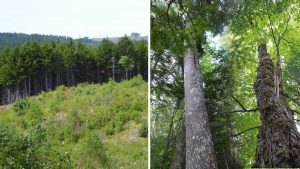A modelling study shows that Protected Areas increase carbon storage, clearcuts reduce carbon storage

Decisions about cutting or not cutting and about how to cut affect carbon storage on our forested landscape.
If the existing and proposed protected areas were managed for forestry they would become a carbon source for the next 130 years for both maximum yield and forestry management with environmental considerations scenarios.
Carbon sequestration refers to the locking away of carbon for long periods of time when it might otherwise be released into the atmosphere as carbon dioxide (CO2).
Increasing carbon storage in forested landscapes is considered essential if we are to achieve the net reductions in CO2 (and other GHG) emissions needed over the next 50 years to keep temperature rise below 1.5 degrees centigrade. So not only do we need to maintain the present levels of carbon storage in forests, we need to increase it.
As well as removing trees that store carbon in their mass by clearcutting, removal of the protective cover provided by trees increases decomposition of coarse woody debris, litter and soil organic matter with the result that some of the stored carbon is released as as CO2.
Soil holds more than 50% of the stored carbon in temperate and northern forests in the form of soil organic matter. Studies conducted on Nova Scotia forests by A. Diochon and colleagues showed that ”storage of [soil] carbon reached a minimum 32 years post-harvest, at which time stores were approximately 50% of the intact forest… storage approached the range of the intact forest approximately 100 years post-harvest”. In Nova Scotia the majority of harvesting involves clearcuts on approx. 55 year rotations. So we are losing a lot of soil organic matter (which has many benefits) and the associated stored soil carbon on those clearcut lands.
Cameron and Bush comment that “it has been suggested that it may be possible to manage forests for forestry in a way that the forests become C [carbon] sinks… Our results do not exclude this hypothesis… changes to how forests are managed can have a significant effect on C sequestration. Practices such as partial harvests which provide enough shade to prevent increased soil microbial activity, may allow soil C pool to increase. At the same time, young regrowth can be established which quickly sequesters more C.”
A recent study conducted in Vermont showed that management of northern hardwood-conifer forests for old-growth characteristics enhances carbon storage.
Not incorporated into the Cameron/Bush model are possible benefits from using more wood in construction. To the extent that trees harvested from the forest are converted to long lasting wooden structures, there is continued storage of some of the carbon removed from the forest by harvesting.
Message to Nova Scotia: more selection harvests, less clearcutting and more use of our forests to make timber can help; prevalent current forest management practices do not. Also, any increase in the formal protection of forested landscapes will help; so will “doing nothing” with a forested landscape.
Think of the multiple benefits for jobs, biodiversity and for mitigating and adapting to climate changes if we pursued more local processing and use of wood as suggested by Robert Taylor, opened up cap and trade to accommodate forest carbon capture as suggested by Dale Prest, and shifted our focus from softwoods to hardwoods as suggested by Tom Miller. ‘Need a plan? Have a look at this 8-stage plan to transition from clearcutting to a selection cutting forest economy as a start.
Cited Lit
Are Protected Areas an Effective Way to Help Mitigate Climate Change? A Comparative Carbon Sequestration Model for Protected Areas and Forestry Management in Nova Scotia, Canada
Robert Cameron and Peter Bush 2016. The International Journal of Interdisciplinary Environmental Studies 11: 1-13.
Looking deeper: An investigation of soil carbon losses following harvesting from a managed northeastern red spruce (Picea rubens Sarg.) forest chronosequence
A. Diochon et al., 2009. Forest Ecology and Management 257: 413-420.
Enhanced carbon storage through management for old-growth characteristics in northern hardwood-conifer forests
Sarah E. Ford and Wiliam S. Keeton. 2017. Ecosphere 8: 1-20.
View also:
Double Bottom Line: Managing Maine’s Forests to Increase Carbon Sequestration and Decrease Carbon Emissions.
Mitch Lansky, March 2016. Summary
An in-depth, critical, comprehensive examination of the opportunities for Maine’s forestry industry to increase carbon sequestration and decrease carbon emissions.
